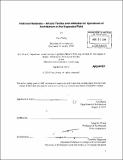Irrational Rationale : artistic tactics and attitudes for operations of architecture in the expanded field
Author(s)
Zhang, Yao, S.M. Massachusetts Institute of Technology
DownloadFull printable version (42.67Mb)
Alternative title
Artistic tactics and attitudes for operations of architecture in the expanded field
Other Contributors
Massachusetts Institute of Technology. Dept. of Architecture.
Advisor
Yung Ho Chang.
Terms of use
Metadata
Show full item recordAbstract
Historically the study of architecture has experienced reiterative marriage and divorce with the arts. Some avant-garde architects once tried to flirt with the arts in the late of twentieth century by artwork analysis and philosophical exploration, but the result unwillingly belies the architects' reluctant surrender - artists seem constantly capable of bringing about innovative pieces with sharp insight and inspiration, while architects strive to question the world but only come up with mimicry form. What is more is that the influence of this incompetence has directly or indirectly led to the current common ignorance of art in the architectural world. My thesis interrogates the traditional perspective considering architecture served as a vehicle of art and proposes a new equality between the identity of art and that of architecture. The thesis argues that the "technical support" coined by Rosalind Krauss in the post-medium condition of art is also a support that confirms or modifies the perceptual and mental process of intellectual creation of architecture. It is not about the "brilliant" idea architecture has to convey but the meditation about the mechanism and "supports" permitting them to act on an idea - the rudiments of a language that express their attitude towards the world. The thesis uses my observations and understandings on diverse examples from contemporary art and architecture practice not as models to imitate but illustrations of what specific "technical support" might signify. Then it employs semiotic square as the generative diagram to compare and distinguish these mechanism and hence to look for a more open, flexible "support" for an architectural practice that is confident in its own modes of operation and intrinsic disciplinary knowledge. The narrative of this thesis is in a form of but not only limited in 'know-how' report for practice but also present a process to communicate my intellectual adventures of what I think of what I have already seen and what I still have not seen, so that the reader can learn by the same process and rely on the explosive power of the semiotic square to search for a continual source of innovation and change.
Description
Thesis (S.M.)--Massachusetts Institute of Technology, Dept. of Architecture, 2010. Cataloged from PDF version of thesis. Includes bibliographical references (p. 249-252).
Date issued
2010Department
Massachusetts Institute of Technology. Department of ArchitecturePublisher
Massachusetts Institute of Technology
Keywords
Architecture.